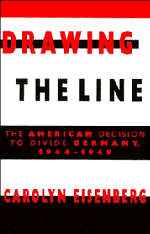Book contents
- Frontmatter
- Contents
- Preface and Acknowledgments
- Germany – Occupation Zones, 1945
- Introduction: Private Polowsky's Oath
- 1 Plans
- 2 Making Peace
- 3 The Limits of Reform: The U.S. Zone
- 4 A Fragile Friendship
- 5 The Russian Challenge
- 6 Bizonal Beginnings
- 7 The Doctors Deliberate
- 8 Marshall's Medicine
- 9 A Separate State
- 10 Cold War Germany
- 11 Winning
- Conclusion: The American Decision to Divide Germany
- Bibliography
- Index
10 - Cold War Germany
Published online by Cambridge University Press: 07 October 2009
- Frontmatter
- Contents
- Preface and Acknowledgments
- Germany – Occupation Zones, 1945
- Introduction: Private Polowsky's Oath
- 1 Plans
- 2 Making Peace
- 3 The Limits of Reform: The U.S. Zone
- 4 A Fragile Friendship
- 5 The Russian Challenge
- 6 Bizonal Beginnings
- 7 The Doctors Deliberate
- 8 Marshall's Medicine
- 9 A Separate State
- 10 Cold War Germany
- 11 Winning
- Conclusion: The American Decision to Divide Germany
- Bibliography
- Index
Summary
We are in Berlin as a result of agreements between the governments on the areas of occupation in Germany and we intend to stay.
(Statement by Secretary of State Marshall, June 30, 1948)After the United States, Britain and France by their separate actions in the western zones of Germany destroyed the system of quadripartite administration … they thereby undermined as well the very legal basis which assured their right to participate in the administration of Berlin.
(The Soviet Ambassador to the Secretary of State, July 14, 1948)Because there was no obvious way to defend the western position in Berlin, U.S. policy makers were at first disorganized and divided. They argued intensely over a range of tactical issues: the relative merits of an armed convoy versus an airlift, the number of planes that could be safely diverted to the German theater, the proper custodianship of atomic weapons, the form and character of Allied protest notes, and even the feasibility of utilizing the Russian eastmark in Berlin. Yet the most crucial decision was the one all the principals took for granted: the refusal to consider German unification.
By insisting on partition, U.S. officials insured that the Berlin crisis must end with either a peaceful Soviet surrender or a Third World War. Eager to avoid armed hostilities, policy makers searched for alternative means of obtaining the Soviets' capitulation. However, their determination to create a separate west German state obliged them not only to risk a war but to develop a realistic plan for winning it. This pushed to the forefront the atomic arsenal, which became the indispensable accompaniment of an ambitious foreign policy.
- Type
- Chapter
- Information
- Drawing the LineThe American Decision to Divide Germany, 1944–1949, pp. 411 - 459Publisher: Cambridge University PressPrint publication year: 1996



